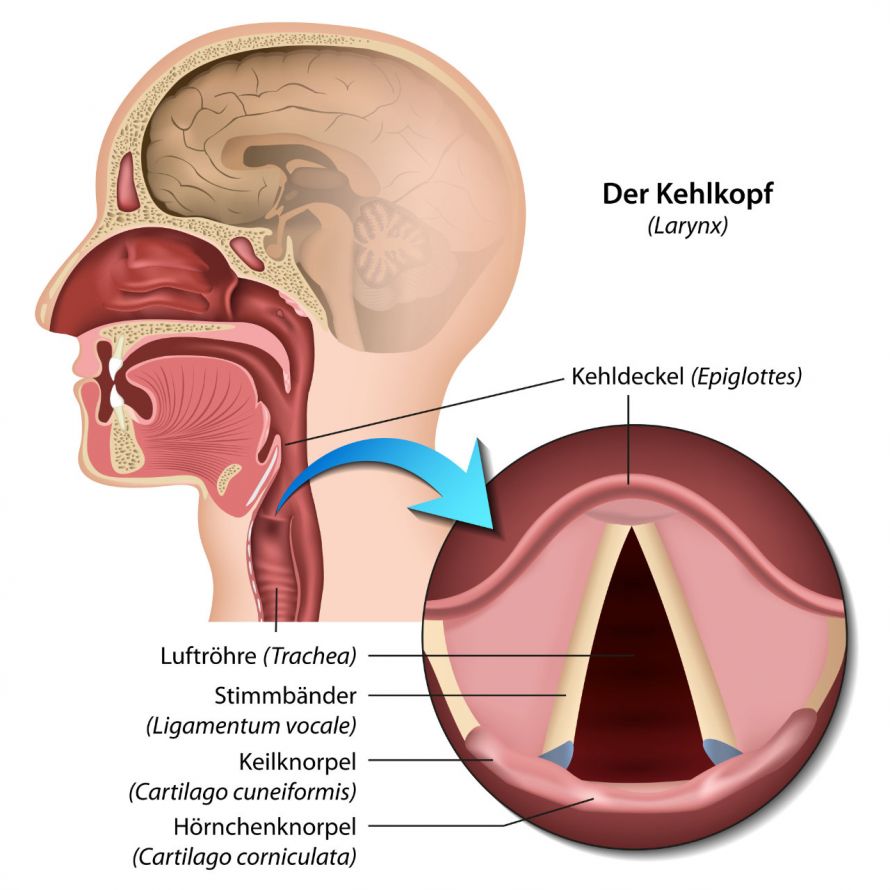Inflammation of the larynx is called laryngitis. Physicians distinguish primarily between acute and chronic laryngitis.
Acute laryngitis
This laryngeal disease is usually a virally triggered inflammation of the vocal cords.
Clinical symptoms include hoarseness with an urge to cough and a feeling of dryness.
Warm and humid inhalations are used for treatment, and sprays in severe cases. In addition, those affected should take care of their voice and refrain from smoking.
In the case of a bacterial (super) infection, additional antibiotic treatment should be given. In this regard, cefuroxime, or clindamycin in the case of allergy, may be considered.
Chronic laryngitis
Chronic inflammation of the larynx is caused by too dry air (air conditioning) or noxious substances (dust, smoking). The vocal cords in particular react sensitively as a result and tend to become inflamed.
For mouth breathers (obstructed nasal breathing), the humidity is also insufficient. This can lead to chronic laryngitis.

The anatomy of the larynx © bilderzwerg | AdobeStock
The symptoms are similar to those of acute laryngitis:
- Globe sensation,
- Hoarseness,
- Cough, and
- A constant urge to clear the throat.
Therapeutic measures include
- The avoidance of noxious agents,
- If necessary, the permanent restoration of nasal breathing, and
- Short-term voice rest with inhalation therapy
Other forms of laryngitis
False croup (acute subglottic laryngitis): False croup is also a primarily viral disease. If a bacterial infection is also present, physicians speak of a superinfection.
In this disease, which occurs in childhood, the mucous membrane below the glottis swells. The child suffers from a barking cough and constricted airways, which are indicated by clearly audible breathing sounds.
Decongestant inhalations and, if necessary, antibiotic treatment with cefuroxime, or clindamycin if allergic, are important. In an emergency, intubation may be necessary.
Tuberculous laryngitis: An M. tuberculosis infection can lead to monochorditis in the larynx. It is characterized by granulomatous changes (granular tissue neoplasms).
The symptoms correspond to the other listed chronic diseases of the larynx. The diagnosis is made by biopsy (tissue sample). Therapeutic treatment is tuberculostatic (triple therapy).
Laryngitis posterior: This type forms due to a reflux disease. In the process, gastric acid repeatedly enters the esophagus. Gastric acid damages the mucous membranes of the larynx, especially in the arytenoid cartilage and interary region.
With redness and swelling, symptoms include hoarseness and an urge to cough.
The therapy consists of reducing/preventing reflux by
- Changing one’s diet and
- Medicating with anti-reflux therapy (proton pump inhibitors).
Laryngeal papillomatosis often occurs in childhood. It is caused by human papillomaviruses (HPV 6/11/16/18). The result is papillomatosis on the vocal cords. Papillomatoses are wart growths caused by viruses.
In children, these often occur in several places on the body; in adults, they often occur in only one place.
Therapeutically, the papillomas are ablated by laser. An inpatient stay of two days is necessary for ablating the papillomas by laser. In addition, active substances can be injected that stimulate the immune system so that it fights the pathogens itself.
The main problem with this disease is the tendency for recurrence and downward spread.
This laryngeal disease is a pathological softening of the larynx, usually congenital. If the structures are too soft, there is a suction effect when inhaling, so that not enough air can pass through. Patients with laryngomalacia show typical breathing sounds when exhaling. These symptoms may be congenital.
In the first few years, the symptoms often improve on their own. Therefore, surgical intervention is rarely necessary. In addition to laser treatment, a temporary tracheotomy (windpipe incision) may be considered.
Laryngoceles are hernia-like bulges in the area of the larynx. Depending on the location, a distinction is made between internal and external laryngoceles.
Common symptoms include
- A globe sensation,
- Swallowing disorders (dysphagia), and
- Difficulty breathing (dyspnea).
The therapy is surgical and mostly performed endoscopically by laser. Open surgery from the outside is rarely required.
Laryngeal cancer is the most common cancer of the throat. Men are affected about ten times more often than women. Smoking and alcohol abuse are considered to be the most common causes of malignant larynx tumors.
Laryngeal cancer is a squamous cell carcinoma, which is a form of skin cancer. Depending on the localization, four types have been distinguished:
- Vocal cords - glottic carcinoma: The tumor is located in the area of the vocal cords and the posterior wall of the larynx.
- Below the vocal cords - subglottic carcinoma: The tumor is located below the vocal cords.
- Epiglottis - supraglottic carcinoma: The tumor is located in the region of the epiglottis.
- Whole larynx - transglottic carcinoma: The tumor extends over the entire larynx.
Treatment is generally by surgical removal of the tumor (tumor resection). Both laser endoscopic and open surgical procedures are available for this purpose.
In the case of larger tumors, postoperative irradiation should be performed. If the tumor is inoperable or if severe comorbidities are present, combined radiochemotherapy is another treatment option. If necessary, antibody therapy may also be used.
Swallowed fish bones and other foreign bodies rarely cause problems when they become trapped in the laryngeal area. However, if complications do arise, removal of the swallowed object is necessary.
Most often, blunt trauma to the larynx occurs, such as that caused by a car accident or motorcycle helmet. Sharp trauma, such as from a knife, is rare.
Due to laryngeal fractures up to a tracheal rupture, dislocation or hemorrhages can cause
It is essential to first secure the airway by surgical reconstruction. The intubation procedure during general anesthesia may cause dislocation (injury) to one or both of the arytenoid cartilages.
With longer intubation times, intubation granulomas can form. Subglottic tracheal stenosis and tracheomalacia in the cuff area often develop in long-term intubated patients. A temporary tracheostomy (tracheotomy) must be performed promptly to prevent these symptoms.
Reinke’s edema is an accumulation of fluid in the Reinke's space of the vocal cords. It results from vocal overload and/or usually smoking, including passive smoking. This results in a hoarse voice, and occasionally a cough.
As a therapeutic approach, the patient should first improve their vocal hygiene and avoid noxious substances. Vocal hygiene is adjusting one’s lifestyle to preserve and protect the voice.
If this does not result in improvement, phonosurgical ablation may be performed. Ablation is performed under general anesthesia during microlaryngoscopy.
Possible complications include permanent hoarseness and the recurrence of edema after surgery.













